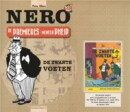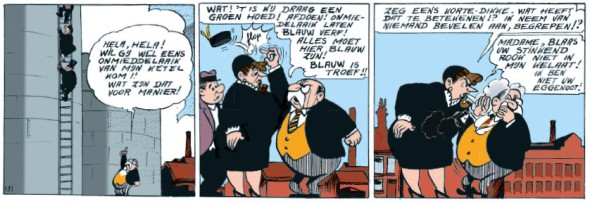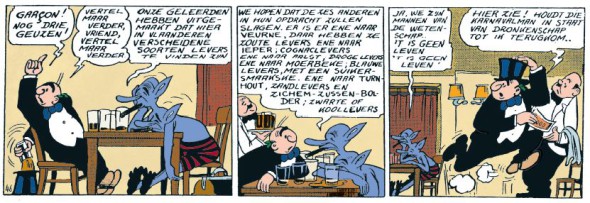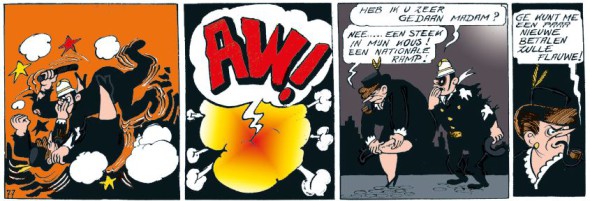
Written by: Marc Sleen
Illustrations: Marc Sleen
Publisher: Standaard Uitgeverij
Nero De Premières #3 Meneer Pheip: De Zwarte Voeten – Comic Book Review
Nero is a comic book character, very well known in Flanders, who appeared in Flemish newspapers almost continuously between 1951 and 2002. His creator, Marc Sleen, started out with a few comic books about Detective Van Zwam, where Nero already played a minor role. Soon though, Nero would take over the lead role and that’s how the adventures of Nero came to be. Detective Van Zwam still plays a part in the Nero comic books, albeit a more minor one.
‘De zwarte voeten’ – The black feet – is one of the earliest albums in which Nero takes the lead. It was originally published in the newspaper ‘Het Volk’ in 1951. This year, the Standaard Uitgeverij decided to republish this album, as part of the series ‘De Premières’. In each of these nine issues we are introduced to one of Nero’s friends, who later keep turning up in other stories. In this album we meet Mister Pheip for the first time as the manager of a sugar factory with quite a French accent flavoring his Dutch.
‘De zwarte voeten’ starts out with Nero taking home a goose after winning a card game. On the way home though, he gets in trouble with his goose, and also at home there is trouble, as his landlord wants him to pay the rent. (Not so) long story short, Nero has to run from the police and hides in a sewer, with the help of his friends Madam Pheip and Petoetje. But after his friends managed to put off the police, they can’t find Nero anywhere, so they call in the help of detective Van Zwam. Meanwhile we learn that Nero has been kidnapped by a blue man with two heads wearing striped swimming shorts. This man comes from the planet Pompelanioem. He tells Nero that he is looking for a real ‘Brusselaar’ to cut out his liver, just as six other blue men are doing in six other Flemish towns. Nero explains that he is actually not a real ‘Brusselaar’, as his mother was indeed from Brussels, but his father was Polish, and thus the blue man runs off. Nero goes after him, because he is afraid he will murder someone else in order to find a liver. That shouldn’t be too difficult for our hero, seeing that the man from Pompelanioem leaves black footprints behind. The Pompelanioem-ian is smarter though, and Nero falls into a container of wet cement. Luckily Madam Pheip, Petoetje and detective Van Zwam find him soon after and liberate him out of this not so comfortable situation.
Nero decides to go after all seven blue men, together with his friends, to stop them from murdering anyone. In Moerbeke, one of the towns where a blue man has to be stopped, they meet the manager of the sugar factory, the soon to be Mister Pheip. At first he is quite angry with Nero & co, but towards the end he even helps Madam Pheip get rid of the police, as he falls for her charms.
The plot of this album is rather serious, as their main goal is to stop the blue men from killing people. The way they try to reach that goal in every town is very funny nonetheless, which makes it very amusing to read. Also, and maybe even more so than the text, the drawings often make you laugh out loud. Not to be underestimated are Nero’s often clumsy approach, Madam Pheip’s eternal quarrels and the often very funny quotes, which all add to the airiness of the story.
The pace of the story is pretty fast, as lots of things are happening all the time, which makes it very interesting to read. Each time you turn a page you wonder what will happen next. Of course it is quite clear from the start that they will be visiting all these towns, but the story is kept interesting because lots of unexpected things happen en route. Also the way they handle the blue men keeps surprising.
Also worth mentioning are the accents of some of the characters, or rather: their dialects. The main characters in this album all speak with a normal Dutch accent, but depending on where they go, people speak in various other dialects. The policeman in Veurne, the first town they visit, for example, speaks in their typical accent. Also the man they meet in Aalst speaks in a dialect known to the neighborhood. The manager of the sugar factory, in later albums known as Mister Pheip, speaks Dutch with quite a heavy French accent, which –by the way- he will keep doing throughout all of the Nero albums. These different dialects and accents make the story quite amusing and airy, although sometimes it does seem to slow down the pace, as you need more time to read and understand what they are saying.
Conclusion
‘De zwarte voeten’ is definitely a fun story to read, with lots of exciting things going on. It’s both fun to read as well as watch the images. As it is a fairly old album, many Flemish people will already know most of the main characters in the Nero comic books, but they may not have read the oldest albums. That’s why it is a very nice initiative of the Standaard Uitgeverij to come up with a series of republications where we actually learn how those characters ended up being such close friends of Nero’s. The look of the series also adds to its overall air of exclusiveness. It is definitely worth the purchase, as young and old will be able to enjoy this fun story.
Nero De Premières #3 Meneer Pheip: De Zwarte Voeten - Comic Book Review,








No Comments